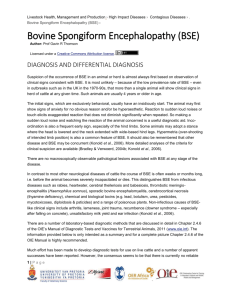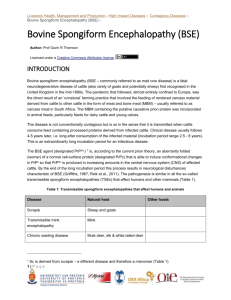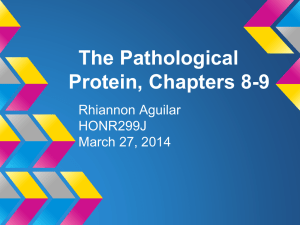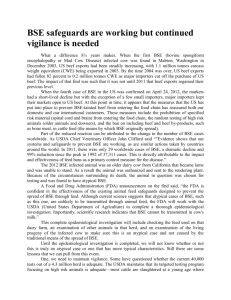Questionnaire
advertisement
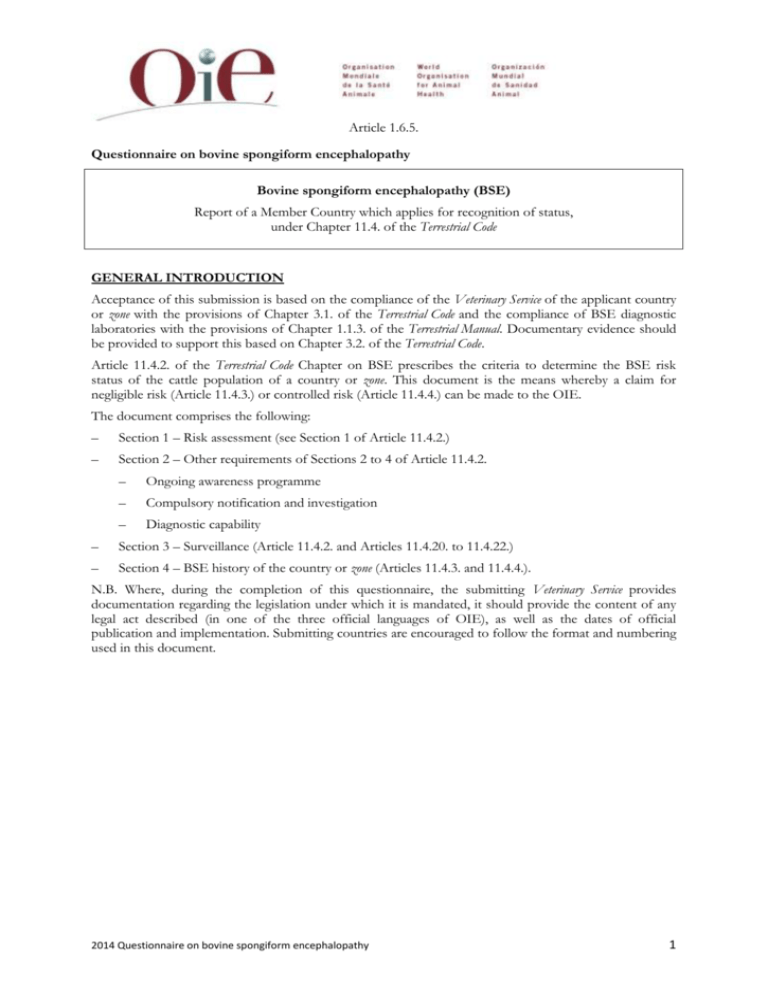
Article 1.6.5. Questionnaire on bovine spongiform encephalopathy Bovine spongiform encephalopathy (BSE) Report of a Member Country which applies for recognition of status, under Chapter 11.4. of the Terrestrial Code GENERAL INTRODUCTION Acceptance of this submission is based on the compliance of the Veterinary Service of the applicant country or zone with the provisions of Chapter 3.1. of the Terrestrial Code and the compliance of BSE diagnostic laboratories with the provisions of Chapter 1.1.3. of the Terrestrial Manual. Documentary evidence should be provided to support this based on Chapter 3.2. of the Terrestrial Code. Article 11.4.2. of the Terrestrial Code Chapter on BSE prescribes the criteria to determine the BSE risk status of the cattle population of a country or zone. This document is the means whereby a claim for negligible risk (Article 11.4.3.) or controlled risk (Article 11.4.4.) can be made to the OIE. The document comprises the following: – Section 1 – Risk assessment (see Section 1 of Article 11.4.2.) – Section 2 – Other requirements of Sections 2 to 4 of Article 11.4.2. – Ongoing awareness programme – Compulsory notification and investigation – Diagnostic capability – Section 3 – Surveillance (Article 11.4.2. and Articles 11.4.20. to 11.4.22.) – Section 4 – BSE history of the country or zone (Articles 11.4.3. and 11.4.4.). N.B. Where, during the completion of this questionnaire, the submitting Veterinary Service provides documentation regarding the legislation under which it is mandated, it should provide the content of any legal act described (in one of the three official languages of OIE), as well as the dates of official publication and implementation. Submitting countries are encouraged to follow the format and numbering used in this document. 2014 Questionnaire on bovine spongiform encephalopathy 1 SECTION 1: RISK ASSESSMENT (see point 1 of Article 11.4.2.) Introduction The first step in determining the BSE risk status of the cattle population of a country or zone is to conduct a risk assessment (reviewed annually), based on Sections 2 and 3 and Chapter 4.3. of the Terrestrial Code, identifying all potential factors for BSE occurrence and their historic perspective. Documentation guidelines This section provides guidance on the data gathering and presentation of information required to support the risk entry and exposure assessments in respect of: Entry assessment: 1) The potential for the entry of the BSE agent through importation of meat-and-bone meal or greaves. 2) The potential for the entry of the BSE agent through the importation of potentially infected live cattle. 3) The potential for the entry of the BSE agent through the importation of potentially infected products of bovine origin. Exposure assessment: 4) The origin of bovine carcasses, by-products and slaughterhouse waste, the parameters of the rendering processes and the methods of cattle feed production. 5) The potential for the exposure of cattle to the BSE agent through consumption of meat-and-bone meal or greaves of bovine origin. In each of the five areas of entry and exposure assessment that follow, the contributor is guided in terms of the question, the rationale and the evidence required to support the country or zone status claim. Entry assessment 1) The potential for the entry of the BSE agent through importation of meat-and-bone meal or greaves Question to be answered: Has meat-and-bone meal, greaves, or feedstuffs containing either, been imported within the past eight years? If so, where from and in what quantities? Rationale: Knowledge of the origin of meat-and-bone meal, greaves or feedstuffs containing either meatand-bone meal or greaves, is necessary to assess the risk of entry of BSE agent. Meat-and-bone meal and greaves originating in countries of high BSE risk pose a higher likelihood of entry than that from low risk countries. Meat-and-bone meal and greaves originating in countries of unknown BSE risk pose an unknown entry risk. This point is irrelevant if the exposure assessment outlined below in Article 11.4.27. indicates that meat-and-bone meal or greaves has not been fed, either deliberately or accidentally, in the past eight years. Nevertheless, documentation should be provided on the control systems (including relevant legislation) in place to ensure that meat-and-bone meal or greaves has not been fed to cattle. Evidence required: a) Documentation to support claims that meat-and-bone meal, greaves or feedstuffs containing either meat-and-bone meal or greaves have not been imported, OR b) Documentation on annual volume, by country of origin, of meat-and-bone meal, greaves or feedstuffs containing them imported during the past eight years. c) Documentation describing the species composition of the imported meat-and-bone meal, greaves or feedstuffs containing them. d) Documentation, from the Veterinary Service of the country of production, supporting why the rendering processes used to produce meat-and-bone meal, greaves or feedstuffs containing them would have inactivated, or significantly reduced the titre of BSE agent, should it be present. 2014 Questionnaire on bovine spongiform encephalopathy 2 2) The potential for the entry of the BSE agent through the importation of potentially infected live cattle Question to be answered: Have live cattle been imported within the past seven years? Rationale: The likelihood of entry is dependent on: – country or zone of origin and its BSE status, which will change as more data become available; this may result from the detection of clinical disease, or following active surveillance, or assessment of geographical BSE risk; – feeding and management of the imported cattle in the country or zone of origin; – use to which the commodity has been put as apart from representing risk of developing clinical disease, the slaughter, rendering and recycling in meat-and-bone meal of imported cattle represents a potential route of exposure of indigenous livestock even if meat-and-bone meal and greaves, or feedstuffs containing them, have not been imported; – dairy versus meat breeds, where there are differences in exposure in the country or zone of origin because feeding practices result in greater exposure of one category; – age at slaughter. Evidence required: 3) a) Documentation including tables on the country or zone of origin of imports. This should identify the country or zone of origin of the cattle, the length of time they lived in that country or zone and of any other country in which they have resided during their lifetime. b) Documentation including tables describing origin and volume of imports. c) Documentation demonstrating that risks are periodically reviewed in light of evolving knowledge on the BSE status of the country or zone of origin. The potential for the entry of the BSE agent through the importation of potentially infected products of bovine origin Question to be answered: What products of bovine origin have been imported within the past seven years? Rationale: The likelihood of entry is dependent on: – the origin of the cattle products and whether these products contain tissues known to contain BSE infectivity (Article 11.4.13.); – country or zone of origin and its BSE status, which will change as more data become available; this may result from the detection of clinical disease, or following active surveillance, or assessment of geographical BSE risk; – feeding and management of the cattle in the country or zone of origin; – use to which the commodity has been put as apart from representing risk of developing clinical disease, the slaughter, rendering and recycling in meat-and-bone meal of imported cattle represents a potential route of exposure of indigenous livestock even if meat-and-bone meal and greaves, or feedstuffs containing them, have not been imported; – dairy versus meat breeds, where there are differences in exposure in the country or zone of origin because feeding practices result in greater exposure of one category; – age at slaughter. Evidence required: a) Documentation on the country or zone of origin of imports. This should identify the country or zone of origin of cattle from which the products were derived, the length of time they lived in that country or zone and of any other country in which they have resided during their lifetime. b) Documentation describing origin and volume of imports. 2014 Questionnaire on bovine spongiform encephalopathy 3 c) Documentation demonstrating that risks are periodically reviewed in light of evolving knowledge on the BSE status of the country or zone of origin. Exposure assessment 4) The origin of bovine carcasses, by-products and slaughterhouse waste, the parameters of the rendering processes and the methods of cattle feed production Question to be answered: How have bovine carcasses, by-products and slaughterhouse waste been processed over the past eight years? Rationale: The overall risk of BSE in the cattle population of a country or zone is proportional to the level of known or potential exposure to BSE infectivity and the potential for recycling and amplification of the infectivity through livestock feeding practices. For the risk assessment to conclude that the cattle population of a country or zone is of negligible or controlled BSE risk, it must have demonstrated that appropriate measures have been taken to manage any risks identified. If potentially infected cattle or contaminated materials are rendered, there is a risk that the resulting meat-and-bone meal could retain BSE infectivity. Where meat-and-bone meal is utilized in the production of any cattle feed, the risk of cross-contamination exists. Evidence required: 5) a) Documentation describing the collection and disposal of fallen stock and materials condemned as unfit for human consumption. b) Documentation including tables describing the fate of imported cattle, including their age at slaughter or death. c) Documentation describing the definition and disposal of specified risk material, if any. d) Documentation describing the rendering process and parameters used to produce meat-and-bone meal and greaves. e) Documentation describing methods of animal feed production, including details of ingredients used, the extent of use of meat-and-bone meal in any livestock feed, and measures that prevent cross-contamination of cattle feed with ingredients used in monogastric feed. f) Documentation describing the end use of imported cattle products and the disposal of waste. g) Documentation describing monitoring and enforcement of the above. The potential for the exposure of cattle to the BSE agent through consumption of meat-andbone meal or greaves of bovine origin Question to be answered: Has meat-and-bone meal or greaves of bovine origin been fed to cattle within the past eight years (Articles 11.4.3. and 11.4.4. in the Terrestrial Code)? Rationale: If cattle have not been fed products of bovine origin (other than milk or blood) potentially containing meat-and-bone meal or greaves of bovine origin within the past eight years, meat-and-bone meal and greaves can be dismissed as a risk. In the case of countries applying for negligible risk status, it will be required to demonstrate that the ruminant feed ban has been effective for at least eight years following the birth of the youngest case. Evidence required: a) Documentation describing the use of imported meat-and-bone meal and greaves, including the feeding of any animal species. b) Documentation describing the use made of meat-and-bone meal and greaves produced from domestic cattle, including the feeding of any animal species. c) Documentation on the measures taken to control cross-contamination of cattle feedstuffs with the meat-and-bone meal and greaves including the risk of cross-contamination during production, transport, storage and feeding. 2014 Questionnaire on bovine spongiform encephalopathy 4 d) Documentation, in the form of the following table, on the audit findings in rendering plants and feed mills processing ruminant material or mixed species containing ruminant material, related to the prohibition of the feeding to ruminants of meat-and-bone meal and greaves. Year (informatio n should be provided for each of the 8 years for effectivenes s is claimed) Year 1 Year 2, etc. e) Type of plant (rendere r or feed mill) Number of plants in (A) inspecte d (A) (B) Total number of visual inspection s in (B) Total number of plants in (B) with infraction s Total number of inspecte d plants in (B) with sampling Total numbe r of plants in (C) with positiv e test results (C) Renderer Feed mill Renderer Feed mill Documentation, in the form of the following table, on the audit findings in rendering plants and feed mills processing non-ruminant material, related to the prohibition of the feeding of meatand-bone meal and greaves to ruminants. Year (informatio n should be provided for each of the 8 years for effective ness is claimed) Type of plant (rendere r or feed mill) Year 1 Renderer Feed mill Renderer Feed mill Year 2, etc. f) Number of plants processin g ruminant material Number of plants processin g nonruminant material Number of plants in (A) inspecte d (A) (B) Total number of visual inspection s in (B) Total number of plants in (B) with infraction s Total number of inspecte d plants in (B) with sampling Total numbe r of plants in (C) with positiv e test results (C) Documentation, in the form of the following table, on each plant above processing ruminant material or mixed species containing ruminant material with infractions, specifying the type of infraction and the method of resolution. Year (information should be provided for each of the 8 years for effectiveness is claimed) Year 1 Type of plant Plant ID (renderer or feed mill) Renderer Feed mill Year 2, etc. Nature of Method of Follow-up infraction resolution results ID 1 ID 2 ID 3, etc. ID 1 ID 2 ID 3, etc. Renderer Feed m ill 2014 Questionnaire on bovine spongiform encephalopathy 5 g) Documentation, in the form of the following table, on each plant above processing nonruminant material with infractions, specifying the type of infraction and the method of resolution. Year (information should be provided for each of the 8 years for effectiveness is claimed) Year 1 Type of plant Plant ID (renderer or feed mill) Renderer Feed mill Year 2, etc. Nature of Method of Follow-up infraction resolution results ID 1 ID 2 ID 3, etc. ID 1 ID 2 ID 3, etc. Renderer Feed m ill h) Documentation explaining why, in light of the findings displayed in the preceding four tables, it is considered that there has been no significant exposure of cattle to the BSE agent through consumption of meat-and-bone meal or greaves of bovine origin. i) Documentation of husbandry practices (multiple species farms) which could lend themselves to cross-contamination of cattle feed with meat-and-bone meal and greaves destined to other species. 2014 Questionnaire on bovine spongiform encephalopathy 6 SECTION 2: OTHER REQUIREMENTS (see points 2 to 4 of Article 11.4.2.) 1) Awareness programme (see point 2 of Article 11.4.2.) Questions to be answered: – Is there an awareness programme? – What is the target audience? – What is the curriculum and how long has it been in place? – Is there a contingency and/or preparedness plan that deals with BSE? Rationale: An awareness programme is essential to ensure detection and reporting of BSE, especially in countries of low prevalence and competing differential diagnoses. Evidence required: 2) a) Documentation indicating when the awareness programme was instituted and its continuous application and geographical coverage. b) Documentation on the number and occupation of persons who have participated in the awareness programme (veterinarians, producers, workers at auctions, slaughterhouses, etc.). c) Documentation of materials used in the awareness programme (the manual, supportive documents, or other teaching materials). d) Documentation on the contingency plan. Compulsory notification and investigation (see point 3 of Article 11.4.2.) Questions to be answered: – What guidance is given to veterinarians, producers, workers at auctions, slaughterhouses, etc. in terms of the criteria that would initiate the investigation of an animal as a BSE suspect? Have these criteria evolved? – What were the date and content of the legal act making notification of BSE suspects compulsory? – What are the measures in place to stimulate notification, such as compensation payments or penalties for not notifying a suspect? Rationale: The socio-economic implications associated with BSE require that there be incentives and/or obligations to notify and investigate suspect cases. Evidence required: 3) a) Documentation on the date of official publication and implementation of compulsory notification. Including a brief description of incentives and penalties. b) Documentation on the manual of procedures for investigation of suspect animals and follow-up of positive findings. Examination in an approved laboratory of brain or other tissues collected within the framework of the aforementioned surveillance system (see point 4 of Article 11.4.2.) Questions to be answered: – Are the diagnostic procedures and methods those described in Chapter 2.4.6. of the Terrestrial Manual? – Have these diagnostic procedures and methods been applied through the entire surveillance period? 2014 Questionnaire on bovine spongiform encephalopathy 7 Rationale: The OIE only recognizes for the purpose of this submission samples that have been tested in accordance with the Terrestrial Manual. Evidence required: a) Documentation as to the approved laboratories where samples of cattle tissues from the country or zone are examined for BSE. (If this is located outside the country, information should be provided on the cooperation agreement). b) Documentation of the diagnostic procedures and methods used. c) Documentation that the diagnostic procedures and methods have been applied through the entire surveillance period. 2014 Questionnaire on bovine spongiform encephalopathy 8 SECTION 3: BSE SURVEILLANCE AND MONITORING SYSTEMS (see point 4 of Article 11.4.2.) Questions to be answered: – Does the BSE surveillance programme comply with the guidelines in Articles 11.4.20. to 11.4.22. of the Terrestrial Code? – What were the results of the investigations? Rationale: Point 4 of Article 11.4.2. and Articles 11.4.20. to 11.4.22. prescribe the number of cattle, by subpopulation, that need to be tested in order to ensure the detection of BSE at or above a minimal threshold prevalence. Evidence required: 1) Documentation that the samples collected are representative of the distribution of cattle population in the country or zone. 2) Documentation of the methods applied to assess the ages of animals sampled and the proportions for each method (individual identification, dentition, other methods to be specified). 3) Documentation of the means and procedures whereby samples were assigned to the cattle subpopulations described in Article 11.4.21., including the specific provisions applied to ensure that animals described as clinical met the conditions of point 1 of Article 11.4.21. 4) Documentation of the number of animals meeting the conditions in point 1 of Article 11.4.21. as compared to the numbers of clinical samples submitted in previous years in accordance to the former provisions in the Terrestrial Code, and explanation of possible differences. 5) Documentation, based on the following table, of all clinically suspect cases notified complying with the definition in point 1 of Article 11.4.21. Laboratory identification number 6) Age Clinical signs Point of detection (farm, market channels, slaughterhouse) Documentation according to the following table, that the number of target points applicable to the country or zone and its BSE surveillance requirements (Type A or type B surveillance as a result of the risk assessment of section 1) are met as described in Articles 11.4.21. and 11.4.22. SUMMARY TABLE FOR BSE SURVEILLANCE Year: (complete a separate table for each year of surveillance) Surveillance subpopulations Routine slaughter Fallen stock Casualty slaughter Clinical suspect Samples Points Samples Points Samples Points Samples Points >1 and <2 years >2 and <4 years >4 and <7 years >7 and <9 years >9 years Subtotals Total points 7) Indicate the number of adult cattle (over 24 months of age) in the country or zone. 2014 Questionnaire on bovine spongiform encephalopathy 9 SECTION 4: BSE HISTORY OF THE COUNTRY OR ZONE (see Articles 11.4.3. and 11.4.4.) Questions to be answered: – Has BSE occurred in the country or zone? – How has it been dealt with? Rationale: The categorization of a country or zone in either negligible or controlled risk is dependent upon, the outcome of the risk assessment described in Section 1, compliance with the provisions described in Section 2, the results of surveillance described in Section 3, and the history of BSE in the country or zone. This section provides the opportunity to describe the BSE history in the country or zone. Evidence required: 1) Documentation of whether a case of BSE has ever been diagnosed in the country or zone. In the case of positive BSE findings: 2) Documentation on the origin of each BSE case in respect to the country or zone. Indicate the birth date and place of birth. 3) Indicate the most recent year of birth in relation to all BSE cases. 4) Documentation that: – the case(s) and all the progeny of female cases, born within two years prior to or after clinical onset of the disease, and – all cattle which, during their first year of life, were reared with the BSE cases during their first year of life, and which investigation showed consumed the same potentially contaminated feed during that period, or – if the results of the investigation are inconclusive, all cattle born in the same herd as, and within 12 months of the birth of, the BSE cases, if alive in the country or zone, are permanently identified, and their movements controlled, and, when slaughtered or at death, are completely destroyed. 2014 Questionnaire on bovine spongiform encephalopathy 10

